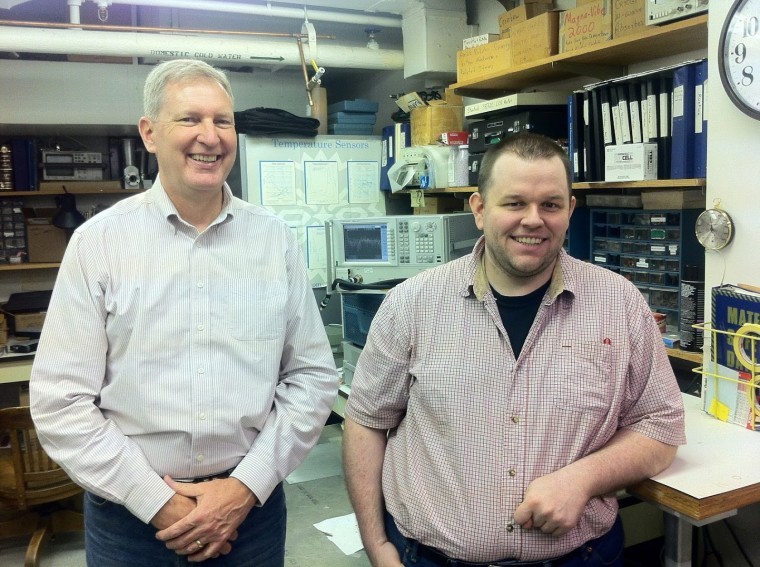
Steven Anlage (left) and Matthew Frazier stand in front of the nonlinear time-reversal mirror. They are among a team of professors who, using a technique called time reversal, discovered how to communicate in any direction using electromagnetic pulses.
Within the next five years, it may be possible to charge a cellphone without knowing where it is and destroy tumors no matter how deep they are within the body, using research conducted at this university.
Through an age-old technique called time reversal, a team of professors discovered how to communicate — by transmitting power, sound or images — in any direction rather than merely across a straight line using electronic magnetic pulses. The team found they could transmit power, such as by charging a cellphone, without knowing an object’s location or disturbing its surroundings. The research — which will be published in the next two months — has been in the works for two years.
“Even to us, it’s a kind of magic,” said Steven Anlage, a physics professor who oversaw the research. “This is the first time this has been done with electromagnetic pulses.”
Unlike its name, time reversal does not turn back the clock; rather, it is equivalent to playing a recording backward before the machine’s antennae receives it. The waveforms are reversed in space and time, allowing the wave to recoil back to its original source using the same path it originally took, said Matthew Frazier, a postdoctoral research fellow in the physics department.
“Imagine recording something like an echo, where you say one word and hear it several times; time reversing that recording properly should ‘undo’ the echoing and you’ll hear a single, backwards copy of what you said to make the echo,” Frazier said.
Previous time-reversal research, which has been around for 10 to 20 years, has focused on linear objects — or motion across a straight line, such as with underwater communication and room acoustics. Those diffuse energy in a simple way, Anlage said. But transmission through nonlinear objects — anything from a cellphone to a rusty nail — is another animal, as the communication can be dispersed in any direction.
In one of many controlled experiments, researchers sent two pictures of the diamondback terrapin to a cellphone from another device using a microwave pulse. But before the cellphone received the photos, a device called a transceiver gobbled them up, recorded and reversed their waveforms and transmitted the time-reversed communication back. While the cellphone received the pictures, a linear device also capable of grabbing transmissions did not — the time reversal of the waves had created a code that only the nonlinear cellphone could comprehend.
“What we’ve done is essentially created a private communication channel; other objects cannot understand the signal,” Frazier said.
Additionally, scientists may one day be able to destroy tumors by tagging them with certain chemicals that respond to rays of destructive heat. The process would be especially useful for deep tumors because surrounding cells would be unharmed.
Concentrated energy could also harness the ability to power up objects wirelessly.
“You walk into a room, put your cellphone down and a mirror will send energy to your phone without knowing where it was — it’s pretty cool,” Anlage said.
Researchers must now figure out how to expand on their discoveries in real-world settings, where the environment is far less controlled than in a laboratory.
“There will need to be much more work to make a robust system that can do things like charging cellphones remotely,” Frazier said.
A similar study by the researchers earlier this year used the same time-reversal strategy to detect small changes in the physics building. The researchers set up a sensor in a stairwell that opened to a large, clear area. They then released waves of communication, which scattered and bounced against the walls while a recorder collected them. After being transferred to a computer, the waves were reversed and retransmitted, undoing the scattering effect. This simplified process allowed the waves to detect any change in the stairwell — from fluctuation in air currents to an object left behind, Anlage said.
At the microscopic level, everything is time-reversible in physics, paving the way for numerous applications, Anlage said.
“It’s the symmetry of nature,” he said.



